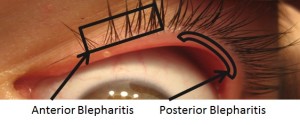What if we told you that there is a condition we see in around 40% of patients but was something that you’ve probably never heard about before? How about if we mentioned that it is the leading cause of evaporative Dry Eye and a main cause of conjunctivitis (“pink eye”)? Maybe we could peak your interest by saying Blepharitis is more common than Glaucoma, Macular Degeneration, and Retinal Detachments… combined!
Now that you’ve met the contributors to Eye to the Future, let’s kick off this educational blog by turning our eye to this largely unknown, nearly ubiquitous, and often overlooked and under treated condition with an in-depth look at Blepharitis.
What is Blepharitis?
Blepharitis (pronounced “blef-ah-RYE-tis”) is a non-specific term for inflammation of the eye lids and is incredibly common; affecting more than 80 million Americans. The inflammation and irritation of the eyelids can occur secondary to several different sources which we will discuss in some detail, but regardless of the cause, the inflammation of those lids vastly affects the quality of the tears and often results in redness, ocular discomfort, Dry Eye Syndrome (DES), acute conjunctivitis (“pink eye”), and an overall poor cosmetic appearance of the eye. The reason for all this is that the eyelids do far more than just blink to protect the eye. With each and every blink, around 40 meibomian glands (or oil producing glands) on each of the four eye lids produce and excrete an oily substance. This secretion acts as an “oil slick” that covers over the watery layer of the tears and decreases the rate at which the tears evaporate into the air. The inflammation and irritation to these eyelids results in the improper function of these oil glands. Compounding matters, we have all been told since childhood to “never get soap in our eyes” which makes the eyelids the only part of the human body that never gets cleaned. This results in inflammatory compounds, oils, and overall crusting building up resulting in further inflammation the surface of the eye and more symptoms. This vicious cycle leads to eyes in bad need of some TLC…
Types of Bleph aritis
aritis
There are two main classifications of Blepharitis- Anterior and Posterior Blepharitis – and these terms are simply based on the location of where the lid inflammation is occurring. Anterior Blepharitis occurs at the front outside edge of the eyelid at the base of the eye lashes and/or further up onto the sensitive eye lid skin. Posterior Blepharitis by contrast occurs at the inner edge of the eyelid next to the eyeball where the meibomian (or oil producing) glands are located.
Now that we know what Blepharitis is and where it occurs, in the next two installments of this series on Blepharitis we will delve further into the different types of blepharitis, what causes each type, what symptoms to watch out for, how these conditions are treated… and maybe even dabble into a little discussion on eyelid parasites! YIKES!
Stay tuned as we keep an Eye to the Future.


